William Drummond, 1st Viscount Strathallan facts for kids
William Drummond, 1st Viscount of Strathallan (born around 1617 – died 1688), was a Scottish soldier and politician. He was also known as Lord Drummond of Cromlix. He served in the Scottish Parliament for Perthshire several times. He was also part of the Convention of Estates in 1678, which was like a special meeting of important people.
Drummond was a Royalist general, meaning he supported the King during the English Civil War. He fought in the "Engagement of 1648." He served in Ireland under the Marquis of Ormonde. He was captured at the Battle of Worcester but managed to escape.
Later, he became a Lieutenant-General in the Russian army. After the King was restored to power in England, Drummond was made Major-General of the forces in Scotland in 1666.
He was once held prisoner for a year in Dumbarton Castle. In 1684, he became the General of the Ordnance, which meant he was in charge of military supplies and weapons. When James VII became King, Drummond was made a Lord of the Treasury, helping manage the country's money.
Contents
Early Life and Military Service
William Drummond was the youngest of five sons of John Drummond, the second Baron Maderty. His mother was Helen Lesly. William was born around 1617 or 1618. He studied at the University of St Andrews.
From 1641 to 1645, he served as a soldier in Ireland. He fought alongside Colonel Robert Monro and later his nephew, Sir George Monro. In 1648, he was with Sir George when they defeated the Marquis of Argyll at Stirling. Later that year, he went back to Ireland to join the Marquis of Ormonde, who was fighting for the King.
Meeting Oliver Cromwell
In 1648–1649, Drummond was in London. He heard Oliver Cromwell talking with Scottish leaders who were against executing the King. Drummond later said that Cromwell was very skilled in these discussions. After seeing the preparations for the King's execution, Drummond quickly joined Charles II in Holland.
At the Battle of Worcester in 1651, Drummond led a group of soldiers. He was captured and taken to Windsor. But he managed to escape and reach the King in Paris. He then secretly returned to Scotland, dressed as a carrier, carrying important messages from the King. In 1653, he joined the Royalists in the highlands, fighting until they were defeated in late 1654.
Serving in Russia
After this, William Drummond asked King Charles for permission to join the Russian army. In August 1655, he went to Russia with his friend Thomas Dalyell. He quickly became a colonel and then a major-general in the Russian army under Czar Alexis Michaelovitch.
In 1662, he led his troops to a great victory against a larger enemy force near Chausy. The next year, he was promoted to lieutenant-general. He fought in many wars against the Poles and Tartars. After the King was restored in England, it was difficult for Charles to convince the Czar to let Drummond leave Russia. He finally returned to England in 1665, with a letter from the Czar praising his service.
Return to Scotland and Imprisonment
In January 1666, King Charles appointed Drummond as Major-General of the forces in Scotland. He also got a seat on the King's council. Some people thought he was a very strict leader, perhaps because of his time in Russia. He was even thought to have brought the idea of the "thumbscrew" (a device used for torture) from Russia.
In 1667, he went to London to tell the King that Scotland needed a strong army and strict rules. He often disagreed with Lauderdale, another powerful Scottish leader. On September 29, 1674, Lauderdale had Drummond imprisoned in Dumbarton Castle. This was because Lauderdale suspected Drummond had been talking with some Scottish leaders who were exiled in Holland.
Later Career and Honors
Drummond was released from prison in February 1676. He was given back his command. Between 1678 and 1681, he was made a Knight. He continued to represent Perthshire in the Scottish Parliament.
In 1684, he became the General of the Ordnance, in charge of military equipment. When James VII became King in 1685, Drummond was made Lieutenant-General of the Scottish forces and a Lord of the Treasury. In April 1684, he also inherited the title of Baron Maderty from his brother. On September 6, 1686, he was given the new titles of Viscount of Strathallan and Baron Drummond of Cromlix.
In March 1686, he went to Westminster to talk with the King. The King wanted to give more freedom to Roman Catholics in Scotland but continue to punish the Covenanters (a group of Scottish Protestants). Even though Drummond was known for being ambitious, he refused to agree to the King's plan. He returned to Edinburgh and joined other leaders in saying they could not do what the King asked. He was described as living and dying "a good Protestant."
Family and Legacy
William Drummond was given a special addition to his family crest by the King. This was a golden lion's head with a red border, which showed his honor.
He passed away at the end of March 1688, at the age of 70. He was buried at Innerpeffray. After returning to Scotland, he married Elizabeth Johnston. They had one daughter, Elizabeth, and a son named William, who became the second Viscount of Strathallan. His son died in 1702. William Drummond's direct male family line ended when his grandson, the third Viscount, died at age 16 in 1711.
Drummond was known for his knowledge and learning. In 1681, he wrote a valuable history of his family.
Images for kids





